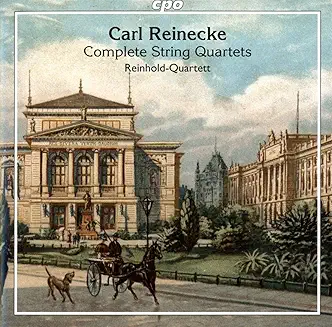Born in Altona, a few miles east-northeast of
Hamburg, Germany, Carl Reinecke (
1824-1910) was one of the most accomplished musicians of his time. A talented violinist, pianist and highly esteemed pedagogue, he would teach at several prestigious institutions.
His students included a number of composers who've appeared in these pages; namely, Edvard Grieg (1843-1907; see
12 July 2013), Sir Charles Villiers Stanford (1852-1924; see
31 December 2018), Amanda Maier (1853-1894; see
31 December 2018), her husband Julius Röntgen (1858-1932; see
31 May 2017), Christian Sinding (1856-1941; see
17 August 2011) and Felix Weingartner (1863-1942; see
8 April 2013).
Also, a distinguished conductor as well as composer, Carl would leave a large
oeuvre across all genres. These encompass a significant body of chamber music, which originally included seven string quartets, two of which have been lost. However, the five surviving ones, all four-movement works, fill out this welcome CPO release, these being the only recordings of them currently available on disc.
Proceeding chronologically, the First (Op. 16, circa 1845) is an amazingly accomplished creation for a twenty-year old. With delicately wrought themes that seem of folk persuasion, it consists of a captivating, sonata-form, "Allegro agitato" [D-1, T-9], which is followed by a melancholy "Andante" [D-1, T-10], having a more hopeful midsection.
Then there's a busy "Scherzo" [D-1, T-11] that smacks of Felix Mendelssohn (1809-1847), whom Reinecke knew and studied with in Leipzig. It's followed by a perky "Finale" [D-1, T-12], which brings this youthful delight to a merry conclusion.
The Second, dating from some six years later (Op. 30, 1851), may remind you of Robert Schumann's (1810-1856) String Quartets (
Op. 41, Nos. 1-3, 1842). In that regard, Robert thought very highly of Carl and even dedicated his
Fugues for Piano (
Op. 72, 1845) to him.
Returning to the Reinecke, we get a vivacious, tuneful "Allegro" [D-1, T-1], succeeded by a gorgeous,
cantilena-like "Andante" [D-1, T-2]. Then a wee, waggish "Scherzo" [D-1, T-3] sets the mood for the scurrying, sonata-rondo "Finale" [D-1, T-4], which ends things assertively.
Twenty-three years would pass before Carl penned a Third Quartet (Op.132, 1874). This was written during his long tenure as Music Director (1860-95) of the great Leipzig Gewandhaus Orchestra (LGO). A more polished, progressive creation, it opens with a playful "Allegro" [D-2, T-5] and heartfelt "Lento" [D-2, T-6], presaging Brahms' (1833-1897) later,
chamber works.
After that, instead of the usual scherzo, there's a chromatically, yearning "Molto moderato" [D-2, T-7]. But then an exuberant "Finale" [D-2, T-8] closes things on a festive note.
The composer's Fourth offering in the genre (Op. 211, 1890) also dates from his LGO years and is characterized by exigency as well as economy of means. Moreover, the first movement [D-1, T-5] has somber "Lento" passages followed by dauntless, "Allegro" ones. Subsequently, there's a sorrowful "Adagio" [D-1, T-6]; however, grief turns to jollity in a petite,
pizzicato-spiced "Scherzo" [D-1, T-7]. This sets the mood for the cheeky 'Finale" [D-1, T-8], which ends with a big 🙂.
Coming a year before Carl's demise, the immaculately constructed, Fifth Quartet (Op. 287, 1909) would be his penultimate composition. Unlike the music of that day by Richard Strauss (1864-1949), Jan Sibelius (1865-1957), Arnold Schoenberg (1874-1951), Maurice Ravel (1875-1937), Béla Bartók (1881-1945) and Igor Stravinsky (1882-1971), it harkens back to Brahms, whom Reinecke highly regarded.
The work seems a moving remembrance of past times and begins with a nostalgic "Allegro" [D-2, T-1], succeeded by a longing "Adagio" [D-2, T-2]. Then there's a restless "Allegretto" [D-2, T-3], where there's a recurring melody [beginning at 00:54], which possibly by design, seems to recall the one accompanying, "Gone are the days when my heart was young and gay", in American composer Stephen Foster's (
1826-1864) song
Old Black Joe (
pub. 1860).
Be that as it may, the work then closes with a mercurial "Finale" [D-2, T-4]. Here a reserved, majestic thought (MP) [00:00] gives way to an ebullient second (ES) [00:43]. ES is explored and followed by a caressing third (CT) [02:26], which undergoes a tender development [02:46]. The latter modulates into the return of ES [04:47] that bridges with hints of CT into a stern reminder of MP [05:35]. This triggers a magnificent CT-ES-MP-based coda that ends the Quartet on a joyful note.
The Reinhold Quartet (violinists Dietrich Reinhold and Tobias Haupt, violist Norbert Tunze, cellist Dorothée Erbiner) deliver superb accounts of these selections. And interestingly enough, all these musicians are members of Reinecke's old alma mater, the LGO (see above).
Made in 2017 (Quartets 1, 2 & 4) and 2018 (Quartets 3 & 5) at the
Großer Lindensaal, Markkleeberg, some five miles south of
Leipzig, Gemany, the recordings present a broad sonic image in pleasantly reverberant surroundings. The instruments are comfortably placed and balanced against one another from left to right in order of increasing size. Incidentally, the 2018 performances sound a tad closer and richer than the earlier ones.
The overall tone is characterized by a good midrange and bass. However, as is usually the case with strings on conventional discs, there are occasional bright spots in the highs. Consequently, this album won't win any audiophile awards.
--
Bob McQuiston, Classical Lost and Found (CLOFO.com, P191229)










